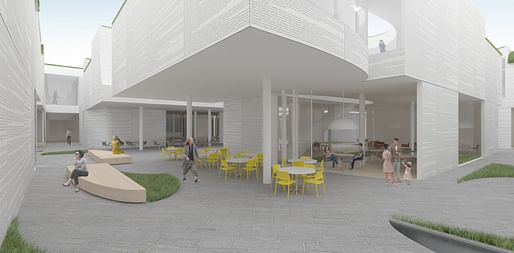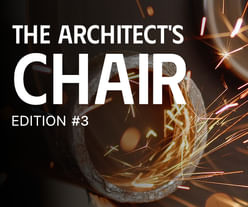
New York-based architecture studio Hou de Sousa took their chances in the National Museum of World Writing International Design Competition in Korea, which was the first large-scale competition that the emerging practice entered. They were thrilled to learn they won second place with their proposal, “Cuneiformed”, out of 126 teams in 40 countries.
Organized by the Ministry of Culture, Sports and Tourism, the competition sought designs for the National Museum of World Writing, which explores the history of writing systems of various countries around the world. Proposed to be built in Incheon, the museum will also serve as a space for cultural and educational public programming. First prize went to “Pages” by Samoo Architects & Engineers, while third prize went to Juhyunkim Architecture's “Deciphering of Hidden Presence”. Indonesian practice Davin Tanasa + Associates and Unsangdong Architects Cooperation were each named as a runner-up. Construction of the museum is currently scheduled to begin in December 2018 with a 2021 opening date.
Hou de Sousa shared more details of their competition entry below.

Project excerpt: “The National Museum of World Writing in Songdo pairs two conditions at odds with one another. The first is the purpose of the Museum: exploring the ancient universality of human communication in written form. The second is its site: the city of Songdo, built in the past decade on a tabula rasa of reclaimed land.
Our proposal for the Museum addresses these opposites, creating a container for the study and exposition of writing as an ancient manifestation of culture in a city whose culture is so new as to be undefined. In the process, we are writing this new city’s culture through architecture.”

“Our strategy addresses these conditions by proposing a form evocative of the very thing Songdo lacks: a history. But rather than employ stereotypical historic architectural forms, we looked for the places where the fundamentals of writing and architecture overlap - solid to void relationships, the trace of gesture on surface, the meaning in the depth of a mark, penetration, or extrusion. And we expressed these on the tabula rasa of the site, cutting into the surface with abstractions of these formal elements. The result is a museum one discovers as if by accident, revealed in the earth as an archaeological site, its repeated modular geometries evocative of the ancient Cuneiform writing system of marks cut into a flat clay surface.”

“Rather than a singular building, the museum reads as a below-grade, unearthed village. Two levels down, visitors circulate on open-air plazas that connect the program components. The components are contained in a ring of circulation and support systems that is entirely below grade. The village components themselves are composed of 7mx7mx5m modules, each of which has a carved void element. These carved elements are inspired by typographic maneuvers shared by all writing systems.
The result is a ‘roof’ that is actually a ground plane of unexpected openings and penetrations that encourage investigation and discovery. Additionally, the voids of each module serve as light wells, clerestories, and small courtyards while simultaneously providing a means of partitioning spaces.”

You can read the rest of Hou de Sousa's proposal on their website. More project images below.

The Last Nuclear Bomb Memorial / Edition #5
Register by Thu, Jan 16, 2025
Submit by Wed, Feb 19, 2025

Museum of Emotions / Edition #6
Register by Thu, Jan 23, 2025
Submit by Tue, Apr 29, 2025

Land Art Generator Initiative 2025 Fiji: Climate Resilience for Island Communities
Register/Submit by Mon, May 5, 2025

The Architect's Chair / Edition #3
Register by Wed, Jan 15, 2025
Submit by Tue, Feb 18, 2025
No Comments